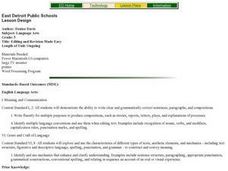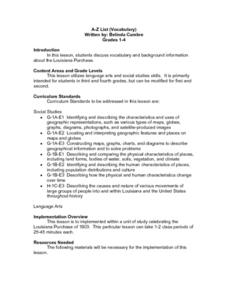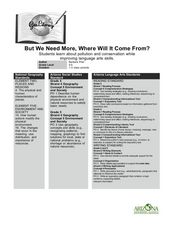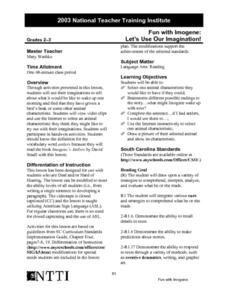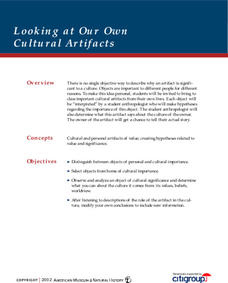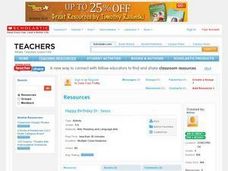Curated OER
Editing and Revision Made Easy
Fifth graders use computer to correct mistakes in written sentences.
Curated OER
The Labors of Hercules
Sixth graders complete a report on one of Hercules 12 labors. In this Hercules lesson plan, 6th graders read a book, view a video, and research the internet on the 12 labors of Hercules and then write a report on one of them.
Curated OER
Making Connections, Linking Population and the Environment
Students find out that all habitats have a carrying capacity. They explore how the world's human population has grown markedly in the 20th century, and that humans impact environmental health. Students investigate that people can and...
Curated OER
A-Z List
Students practice using vocabulary terms about the Louisiana Purchase by creating a picture dictionary, an ABC book of terms, a word sort, or a game. Each project should include people, places and terms as they relate to the Louisiana...
Curated OER
Map Reading
After examining a map from 1803 and 2003, they explore how to become map readers. They describe what they see on the map from 1803 and compare the information to the map from 2003. Students create their own map of the neighborhood that...
Curated OER
Writing: A Friendly Letter
Young scholars practice writing career oriented letters and filling out job applications. As a class, they review the proper ways to make citations and identify the difference between the various types of letter formats. They use peer...
Curated OER
But We Need More, Where Will It Come From?
Students write a persuasive letter and create a poster about pollution and conservation. In this pollution and conservation lesson plan, students learn how humans are the number 1 cause of pollution.
Curated OER
Taxation Without Representation
Eighth graders empathize with how colonists felt when they were taxed without representation. They use a metaphor of students and a school principal to describe the strained relationship that developed between the colonies and Britain.
Curated OER
Fun With Imogene: Let's Use Our Imagination!
Students research animal characteristics and use their imaginations to tell about what it would be like to wake up one morning and find that they have some animal characteristic. They read Imogene's Antlers by David Small.
Curated OER
Comparing Fairy Tales
Students read and review common fairy tales and come up with a list of characteristics from them. The Teacher models filling out either a compare & contrast graphic organizer comparing two fairy tales.
Curated OER
Growth of a Nation: Trading Cards
Students research and write about events and people that have contributed to the development of Canada. They develop their paragraphing skills and create a package of 10 Canadian History Trading Cards.
Curated OER
Library Scavenger Hunt
Students work together to locate and identify resources in the library. They use the internet to answer research questions. They share the information they gathered with the class.
Curated OER
Controlling the Flow of the Colorado River: A Study of Dams
Students research and map the Colorado River and its dams and predict the effects of a dam on an area. They suggest reasons a dam would be built and compare the Colorado River system with other major river systems within the US and...
Curated OER
In the Poet's Shoes: Performing Poetry and Building Meaning
Learners explore poetry by completing a webquest in which they hear poets reading their own work. Later, they examine the dramatic impact of reading poetry out loud. Finally, they practice reading poetry aloud and performing.
Curated OER
Gingerbread Baby v. Gingerbread Boy #7
Students compare and contrast the gingerbread baby in their story to the original gingerbread boy. They use a Venn diagram to easily see the similarities and differences.
Curated OER
Gingerbread Baby Board Game #10
Learners are read the book "Gingerbread Baby". They examine the journey the baby traveled in the story and in turn create a game board. They draw pictures along the board to show different parts of the story.
Curated OER
Artifacts
Learners examine different artifacts and determine the difference between personal and cultural objects. They collect items from their home of cultural importance as well. They identify all they can from artifacts they are given to analyze.
Curated OER
"EA" Beach
Students are introduced to their new spelling words for the week which have the sound "ea". In groups, they brainstorm a list of other words with the same sound, draw them and write them on a worksheet. They share their new words with...
Curated OER
Cooperative Learning Groups Cooperate
Students apply Bloom's Taxonomy to reading selections. They prepare questions for each level of Bloom's Taxonomy and exchange them with other groups to answer. They answer another group's questions and report to one another.
Curated OER
Happy Birthday Dr. Seuss!
Students read "Green Eggs and Ham" in celebration of Dr. Seuss's birthday and visit a storymaker website. Students create and type a three scene story using characters from Dr. Seuss's books and share their story with the class.
Curated OER
Wacky Web Tales
Students study the parts of speech and then review them. They identify each part of speech and place them on a tree map. Then they visit a website to create a "Wacky Web Tale" using information from the tree map. They print their tales...
Curated OER
Developing Thinking and Reasoning Skills in Primary Learners Using Detective Fiction
Young scholars are introduced to the genre of detective fiction. Based on their reading level, they are given a different series of books to read. For each story, they are to make predictions and practice decoding messages. To end the...
Curated OER
Listen to This
Seventh graders listen to a set of instructions and complete a drawing. In this listening skills lesson, 7th graders listen to a set of oral directions and follow a command. Students then listen to a second set of directions to draw a...
Curated OER
Postcards from the Edge: Endangered Species
Students use the internet to identify the endangered species in their state. Using this information, they create a postcard with a picture of the animal along with facts. They discuss the main reasons to protect the endangered species...
